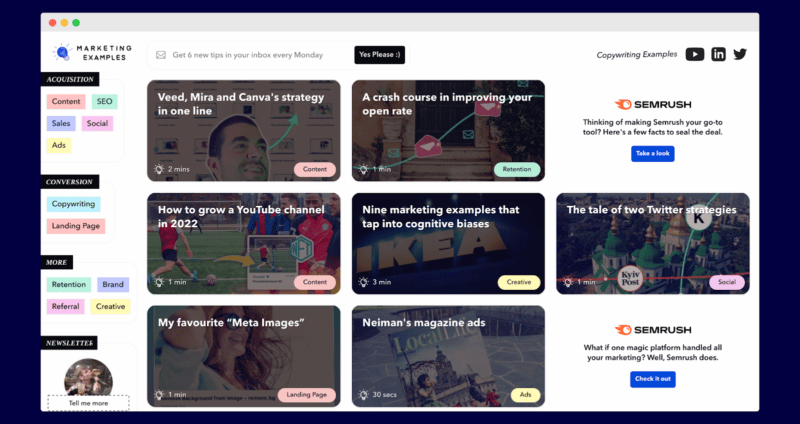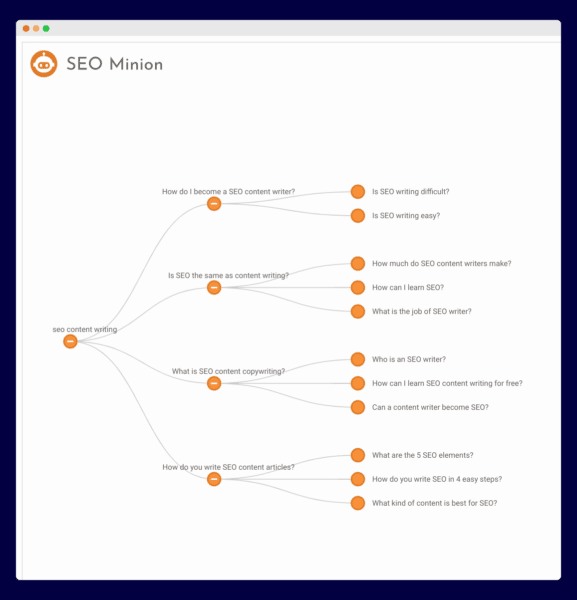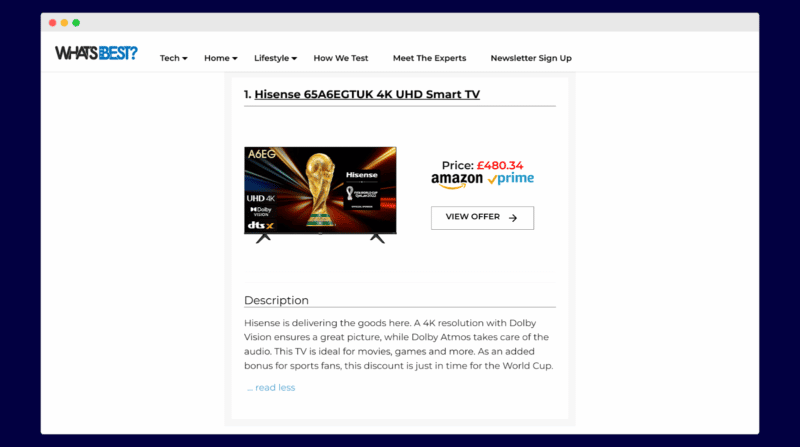
SEO content writing vs. content writing: The key difference
SEO content writing, what exactly is it? And how does it differ from typical content writing?
Is SEO content writing better than more traditional content writing?
In this article, we’ll answer these questions and a lot more.
You’ll learn:
Contents [show]
- The key difference between SEO content writing and content writing
- Which is best? SEO content or regular content?
- Human leverage: The focus of content
- ‘Content bothism’: A secret weapon for marketing success
- 3 content tactics you can use to leverage humans
- SEOs ruined the web – and only SEOs can fix it
- 9 ways to create useful SEO content that humans love
- What you should do next
The key difference between SEO content writing and content writing
The difference between SEO content writing and content writing is that SEO content writing is designed to leverage search engines to fuel the discovery of your content. In comparison, content writing is content only created for humans to read.
If you felt like the above was written by a robot, and for a robot – you’re right. It’s a classic example of a paragraph created for SEO.
I can almost hear my Google home mini spitting that out as a response to a question. It isn’t exciting, but it gets to the point.
I’ll make the rest of the article more “by a human, for humans.” But my first statement is correct.
SEO content is written to leverage the code of search engines.
But which is best?
Which is best? SEO content or regular content?
Over the years, I’ve had a fair amount of success with both forms of content.
Today, I write daily on Linkedin and have grown a decent following.

But that’s social content leveraging the platforms’ algorithms.
When I talk about regular content, I talk about blog posts with zero keyword research.
They’re written for a human reader, and if Google finds some keywords, great. But that’s accidental.
Regular content is a brave thing to create. It’s risky and a step into the unknown, and unless you have a promotion strategy, the likelihood is high that no one will ever read your post.
It might be your ideas, theories or passion.
In contrast, SEO content has a purpose – to rank.
The simple idea is that you’re writing this for search engines and humans.
You’re ranking the content so the content can be discovered via organic search.
Unless the content is written only with search engines in mind, you’ll struggle to have your content discovered.
Does that make SEO content better? No.
As we’ll see shortly, an abundance of content sticks its fingers up at search engines and does pretty well.
Get the daily newsletter search marketers rely on.
Human leverage: The focus of content
Okay, so you have two types of content. We’ve seen that one leverages search engines.
But what does the regular kind of content leverage?
Humans.
In particular, human attention and human interaction.
Content for search engines tries to do this. Arguably, that’s the fundamental skill of an SEO-focused content writer – trying to write content that is loved by both search engines and humans. And it’s a real challenge.
On the other hand, content writers are not concerned with these things.
They share ideas, news, thoughts, opinions and information of use.
Unconstrained by the needs and wants of search engines, a certain freedom allows them to focus on one thing, to change the reader’s emotional state.
That state might be that they feel that:
- Their ideal future can be realized.
- Their goals are closer.
- They aren’t failing as parents.
- Life can be better.
- Their business can succeed.
Be it entertaining or educating. Angering or mind-altering.
Great content makes emotional change happen – and it can be powerful.
But which type of writing is right for your business?
‘Content bothism’: A secret weapon for marketing success
A good SEO once told me that one of his first SEO tasks is to kill low-traffic pages.
I get that. But low traffic doesn’t mean low use.
Before you kill content, you need to be sure that the content isn’t of use.
You might test this by promoting on social, even spending a bit of money to boost a post. That way you’ll know if the content is useful to your customers.
The thing is, it doesn’t have to be just SEO content or regular content. It should be SEO content and regular content.
“Content bothism” means using both types of content for your website. You can have the best of both worlds. And very often, that’s how you can build a powerful online presence.
So, what types of regular content can you create for people that don’t leverage search?
3 content tactics you can use to leverage humans
Just because search is excellent, it doesn’t mean we throw regular content under the bus.
Once you know how to leverage human readership, you can create content that drives people to your site because it’s brilliant.
Here are three ways to leverage great content.
Variable reward content
Great blogs keep you coming back for more, as you never know what you’ll read on them. This is known as variable reward content.
Social platforms such as TikTok and Instagram leverage variable reward content, but so do great websites.
A great example of this is Tim Ferriss. His blog keeps you coming back for more because you never know what you’ve missed.

As a business, this kind of content is excellent because people search for you, not find you serendipitously through search.
The aim is simple – to hook the reader and get them coming back to you, time and time again.
User-generated content
Our next tactic is to get people to create the content for you.
Starter Story has done a super job of doing this.

Through email interviews, their site has hundreds of great start-up stories.
And they haven’t had to write them. This has provided their site with over 4,000 case studies.
Even if you manage to read them all, they keep adding more each week.
None of these are written for search engines, but the volume and the nature of the content are a magnet for readers.
Content curation (with insight)
Content curation is nothing new. Websites have been using content curation for years, and Reddit is arguably the best on the web.
But when you add your unique insight, you tend to create a new version of the content.
Marketing Examples is an excellent example of this. The best marketing examples are curated in one location, with unique views and images.

But does SEO content have to be dull and robotic?
Not a chance.
SEOs ruined the web – and only SEOs can fix it
We’ve all heard the stories Google is losing market share to TikTok.
We all hate reading an article that is thin and only ranked because of the power of the domain behind it.
Hopefully, recent algorithm updates will change this. But if we want SEO content to be better, SEOs and their content writers need to change this.
So, what do people want from good SEO content?
Good SEO content answers the search query and adds what wasn’t there before.
It’s the proper combination of content writing and SEO content writing. You answer the search query, and then you go beyond.
Seth Godin has some excellent tips for writing blogs that work well.
“Cross out every sentence that could have been written by someone else, every box check, every predictable reference. Now, insert yourself. Your truth and your version of what happens next.”
While we don’t want to cross out every sentence, excellent SEO content must add your unique views, experience and truths.
And if you’re struggling to see examples of this in action, look no further than the Backlinko blog.
Brian Dean created a blog that didn’t just leverage search. It leveraged both humans and search engines.
Dean creates content for search engines and still adds unique angles and experiences.

It’s why content UX, content design and the insertion of unique views and experiences matter more than ever.
But others also do this well.
BuzzSumo created an awesome content piece, 18 Examples Of Awesome B2B Content Marketing.

It’s geared toward search and has had some success, but the BuzzSumo team leveraged their own data to produce a great and interesting article.
So, how could you start to make your SEO content stand out?
9 ways to create useful SEO content that humans love
Here are some ways to create helpful content for search engines and humans.
1. Add your own data
We saw how BuzzSumo added its data to create a unique content angle.
What data do you have that you can use?
2. Add design
Brian Dean pioneered content design for SEO, but graphics can add a story to your content that you haven’t thought of.
I get a lot of feedback for my simple graphics that help to explain topics.

3. Add facts
Facts make your content legit and reaffirm what you’re trying to say.
You can get these facts from sites such as Statista.
4. Insert videos
Copywriter Ben Settle used to record himself talking on his phone while walking his dog. He’d then sell these insights as upsells for products.
I’m not saying you should do this, but create a short video, post it on YouTube, and embed it on your page.
Perhaps you can explain something further or add a unique angle. Either way, you’re adding things for humans within your SEO content.
5. Add unique H2s (that don’t feature in the SERPs)
Modern web writing can be a tad regurgitated. People use tools such as Frase and Surfer to analyze the SERPs.
To stand out, aim to add something new to the web, not just combine the best H2s and rewrite them.
What H2 can you add? What is the article missing?
To find out what’s missing, use the SEO Minion Chrome extension, and you can generate relevant People Also Ask questions for any keyword. Then add H2s not listed into your content.

6. Add quick answers
Yes, this is a search issue. We know search loves quick answers.
Today, I wanted to know some brief details about a TV I’m thinking of buying. I just wanted the information quickly. Many other buyers are like this, so try and get to the point.
Quick answers can be placed into boxes on your page to assist readers in finding key information.

The above page by What’s Best allowed me to scroll through the best TVs and quickly gain information.
Optimize for the fast reader.
7. Add specifications, details and numbers
With AI on the rise, you must add details because that’s what AI can’t add. Ensure you’re adding relevant product and service data within the body of your content.
This content by Quality Comix, which rates the 100 most valuable comics, provides key data that no AI program would have.

If you’re using AI to aid in content writing, you need to add more elements that it couldn’t have known or covered.
8. Commit to real answers
Experts give accurate answers to real problems. Quora was built on this.
Again, AI is vague while experts commit. If someone asks whether an air fryer is terrible for your health, answer the question firmly, not vaguely.
Backing up your view with factual data helps, too.
9. Get quotes from business leaders
Businesses have business leaders. Get quotes from them, add them to the content and make your content pop.
Make these quotes stand out on the page using design, and you’ll find that it helps your content to read a lot better.
What you should do next
SEO content is restricted to answering questions your customers have.
Content answers the questions that they don’t know to ask.
Both are needed for a successful content strategy.
Remember, your content is probably not good enough for humans if you wouldn’t pay to promote the content. So go and conduct a review of your content.
Is it good enough? Could it be better? If so, go to work and add some of the elements above.
Be brave. Be bold.
That’s the future of both types of content.
Opinions expressed in this article are those of the guest author and not necessarily Search Engine Land. Staff authors are listed here.
New on Search Engine Land
About the author

Andrew Holland is Head of Organic at Embryo, one of the UK’s fastest-growing digital agencies.
His SEO background stems from a 17-year career in the police, where a number of years were spent within intelligence, utilizing SEO within internal systems to catch criminals. After developing chronic asthma, Andrew left the police and launched a freelance SEO and digital marketing career, and has worked with a wide range of clients, from SMEs to 8-figure businesses. Today, he manages a growing team of in-house content writers and SEO account managers.





